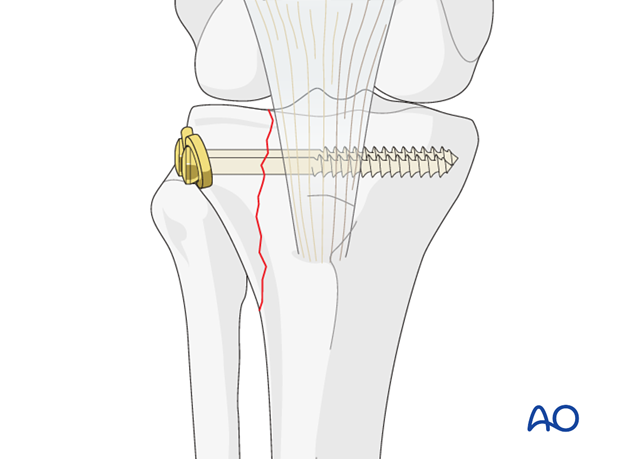ORIF - Lag screws
1. Principles
Anatomical reduction
Anatomical reduction of the articular fracture component and fixation with absolute stability is mandatory.
Lateral versus medial condylar fractures
The operative procedures for lateral condylar fractures and medial condylar fractures are comparable. A lateral condylar fracture treatment is shown here.
Due to the axial forces acting on this lateral split wedge fragment, this injury usually requires a buttress plate as simple screws may not hold the reduction as securely; especially in older patients.

2. Patient preparation and approach
Patient preparation
This procedure is normally performed with the patient in a supine position.

Approach
For this procedure an anterolateral approach is used.

3. Reduction
Clamps
Indirect reduction may be attempted by external manipulation of the fractured fragment using clamps. The accuracy of reduction should be checked with an arthroscope if no arthrotomy is carried out. In cases where adequate closed reduction is not achieved the joint must be opened in order to carry out an anatomical reduction of the joint surface. This may also be necessary to repair the lateral meniscus which is often injured in association with these fractures.

Clinical image showing the clamp application.

4. Fixation
Lag screw application
Once reduction of the joint fragment is obtained, two partially threaded cancellous bone screws are inserted to securely fix the fracture. In cases of good bone substance, stable fixation may be easy to obtain and no further implants are needed.
Click here for a detailed description of the lag screw technique.

Washers
The cortex in the lateral tibial head is thin. Therefore, the use of washers is advised.

5. Aftercare
Compartment syndrome and nerve injury
Close monitoring of the tibial compartments should be carried out especially during the first 48 hours after surgery to rule out compartment syndrome.
The neurovascular status of the extremity must be carefully monitored. Impaired blood supply or developing neurological loss must be investigated as an emergency and dealt with expediently.
Functional treatment
Unless there are other injuries or complications, mobilization may be performed on post OP day 1. Continuous passive motion (CPM) splints are very helpful in the early phase of rehabilitation. Static quadriceps exercises with passive range of motion of the knee should be encouraged. Afterwards special emphasis should be given to active knee and ankle movement.
Following any injury, and also after surgery, the neurovascular status of the extremity must be carefully monitored. Impaired blood supply or developing neurological loss must be investigated as an emergency and dealt with expediently. The goal of early active and passive range of motion is to achieve as full range of motion as possible within the first 4 - 6 weeks. Optimal stability should be achieved at the time of surgery, in order to allow early range of motion exercises.
Weight bearing
No weight bearing in the treatment of articular fractures for a minimum of 10 – 12 weeks.
Follow up
Wound healing should be assessed on a short term basis within the first two weeks. Subsequently a 6 and 12 week follow-up is usually performed. If a delayed union is recognized, further surgical care will be necessary and should be carried out as soon as possible.
Implant removal
Implant removal is not mandatory and should be discussed with the patient.













